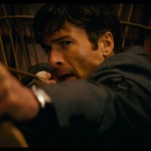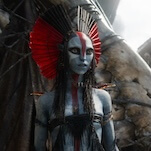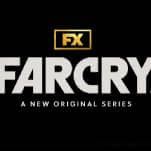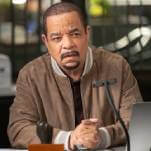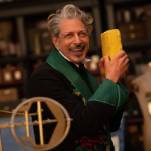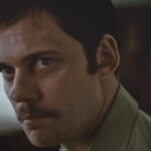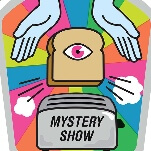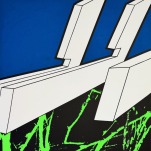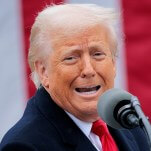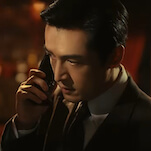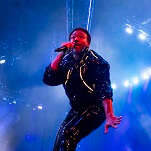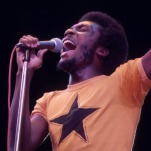And speaking of The Flash, this month also sees the rebooting of his proper series, with Barry Allen once again doing time in the red suit following the Rebirth miniseries. The Flash #1 (DC) finds Allen again assuming duties as a police scientist, and ends with some time-traveling superhero science that pits him against future variations on his greatest enemies. The script by Geoff Johns (yes, again) combines a police procedural with big Silver Age ideas, which feels just about perfect for The Flash, and Francis Manapul’s art gives it a sketchy realism flexible enough to accommodate super-speed adventures… A-
Brendan McCarthy’s striking, psychedelic-inspired imagery only rarely appears on comics stands these days, but it’s always worth a look when it does. Giving McCarthy the freedom to play with Doctor Strange, whose mystic adventures into oddity are limited only by the imagination of the writers and artists working with him, proves an inspired choice in the first issue of the three-part McCarthy-drawn series Spider-Man: Fever (Marvel). Spidey gets his name above the title and plays a major role, but Strange’s investigations into spider demons and other threats mentioned in a forgotten book by an Aleister Crowley type are what make up the meat of the story. By the end of the issue, Strange has set off in search of Spider-Man’s stolen soul. While Spider-Man: Fever is thus far little more than weirdness for its own sake—with plenty of respectful nods to Spider-Man and Strange co-creator Steve Ditko along the way—it may not really need to be anything more… B+
Peter Bagge’s not-so-yearly update on the life and times of his signature character Buddy Bradley takes up about half of Hate Annual #8 (Fantagraphics); as always, Bagge uses the cranky Buddy and his ex-wildcat wife Lisa as a case study in how hard it can be to maintain cool-cred while raising a family and running a business like any other square. In “Lisa Leavenworth-Bradley Discovers Her Creative Outlet,” the couple meets what looks like a simpatico husband and wife at their son’s elementary school, only to find that they aren’t as up for the rock ’n’ roll lifestyle as their new friends. It’s a funny story with a confident, natural progression and some keen observations to make; overall, it’s on much solider ground than Other Lives. The rest of the issue is taken up with a good selection of Bagge strips: several about how the legends of science dealt with skeptics, one imagining what it was like on the set of Reefer Madness, one about how annoying the language of talk radio can be, and so on. The lack of any recent strips from Reason (most of which were recently collected in the book Everyone Is Stupid Except For Me) leaves a notable hole in Hate Annual #8, since Bagge’s political commentary is some of his strongest, most personal work these days. But this is still a welcome renewal of one of alt-comics’ most treasured series… A-
Dash Shaw gets to stretch out more—way more—in his new graphic novel, BodyWorld (Pantheon). The anticipated follow-up to his breakout book, Bottomless Belly Button,BodyWorld collects and expands Shaw’s serialized webcomic, and it’s a rare example of the hype not doing it justice. A sprawling science-fiction fever-dream that takes place in a post-apocalyptic high school (kinda), the story takes place in some murky corner of Shaw’s brain where time, perception, emotion, and even human metabolism are all raw materials for the sculpting, where memories manifest like graphic phantoms, and the subconscious bubbles up in textual blurts. The book’s design is just as sublime, and just as intrinsic to the overall vibe; Shaw’s lush-yet-angular artwork—which is deceptively deeper than it first seems—takes random detours into world-building splashes, foldout pages, and dead white space. Few comics since the early issues of Love And Rockets have instantly crafted such a vivid, self-contained identity, vocabulary, and cosmology; that said, there’s nothing remotely retro about it. BodyWorld is wholeheartedly, and in the best possible sense, the comic book of the future… A
We’re way beyond the point where the very idea of a 170-page biography in comic-book form is novel enough to merit recommendation. That’s good, because historian C.C. Colbert and French cartoonist Tanitoc make such a dreary muddle of the John Wilkes Booth story in Booth (First Second) that no comics fan should feel obligated to slog through it. Colbert has a strong command of the facts of Booth’s life—his love of theater, his fervent support of the Confederacy, his petty hypocrisies—but when reduced strictly to dialogue, her writing has a remedial quality, like something more suited to children’s theater. (Whoring and violence aside.) And Tanitoc’s art is stiff and murky, making it hard to distinguish the characters or their actions. Booth’s story is fascinating enough to survive this stilted adaptation, but comics fans with an interest in Booth would be far, far better-served by Rick Geary’s masterful The Murder Of Abraham Lincoln, which is just as historically accurate and has the advantage of being entertaining… C-
The intro to the corny advice book Everything I Need To Know I Learned From Peanuts (Running Press) promises that the 100 or so ensuing pages of comics and quotes from Charles M. Schulz will offer “some of the best life lessons, as told by the wisest group of kindergarteners on the planet.” Whoever wrote that (possibly editor Cindy De La Hoz, though the intro is uncredited) has such a fundamental misunderstanding of what Peanuts is that it reflects badly on the whole book. Peanuts is about a group of kids of different ages—not all kindergarteners—who endure anxiety, depression, and disappointment. It’s a philosophical strip at times, yes, but it’s just as often bitter, befuddled, or outright weird. And while the strips chosen for Everything I Need To Know range from good to great, very few of them illustrate anything like “life lessons.” In the end, this book is just another cash-in Peanuts collection, with a frustratingly sparse selection and a misguided attempt to ascribe meaning—and sometimes the wrong meaning—to a strip that was rarely as cute as some presume… D
On the other hand, Schulz himself often claimed that one of the projects he was proudest of was the corny bestseller Happiness Is A Warm Puppy, which matched pop-philosophizing to cutesy drawings of Peanuts characters. But then, Schulz was a man of contradictions—simultaneously proud and humble, spiritual and skeptical, self-pitying and egotistical. The collection My Life With Charlie Brown (University Press Of Mississippi) is a welcome addition to any Peanuts fan’s library, bringing together essays, book intros, lectures, and other pieces that Schulz wrote over the years. Even more than the recent batch of Schulz bios, My Life With Charlie Brown digs into what the man himself thought about his life’s work, and his place in the culture at large. Unlike some artists who pretend not to understand what they do, Schulz was always highly analytical, and fairly honest about his shortcomings as an artist and a man. His insights into the process of creation and the other work that inspires him are far more profound and valuable than any piece of coffee-table kitsch… A-
Of course, if you’re on a Peanuts kick anyway, you might as well go straight to the source with The Complete Peanuts: 1975 To 1976 (Fantagraphics), the latest volume of Schulz’s original strips, presented in chronological order. The mid-’70s found Schulz pushing the strip further and further into the oddball, mixing fantasy and reality in extended storylines like Peppermint Patty renting Snoopy’s doghouse to fly in the Powder Puff Derby, or Snoopy and Linus warring for the affection of the same girl. In the midst of all that, Charlie Brown meets his baseball hero Joe Shlabotnik (the new manager of the Waffletown Syrups!), Sally’s one-sided chats with her school cause the building to collapse, and Snoopy introduces his itinerant cousin Spike. Having gotten a lot of comic mileage out of Snoopy as a jack-of-all-trades earlier in the decade, Schulz in ’75 and ’76 began to position the dog as more world-weary, whether he’s casually proclaiming his prowess as an attorney (“the first thing they teach you in law school is the joke about the farmer and the three hogs”) or admitting that he never really knew his mother. (“Mom belonged to a little theater group and was never home very much”) The strip as a whole feels less scrappy and more settled in this era, though it’s no less inspired, and Schulz was clever enough to keep working his own state of mind into the finished product. The Complete Peanuts: 1975 To 1976 collects comics clearly drawn by a successful man still nagged by feelings of inadequacy not easily explained away… A-
The story of Rock ’N’ Roll Comics is, if nothing else, an interesting study of the history of indie comics and the legal landmines their creators once had to navigate. Once published by Todd Loren under his Revolutionary Comics imprint, its proudly snotty determination to tell the story of his rock idols in an “unauthorized and proud of it” manner made it a big underground success—and led to a number of lawsuits from the likes of Bon Jovi and Mötley Crüe. Now, more than 20 years later, a new publisher is reprinting the stories for a generation of readers likely to receive them in a completely different way. Rock ’N’ Roll Comics Vol. 2: Hard Rock Heroes (Bluewater) focuses on the hard-rock and heavy-metal performers whose fans made the original series a subversive hit, but they’re being re-released to a different world. The sex, violence, and drugs are pretty tame by today’s standards, and somehow, with official sanction, they seem less radical. Bluewater specializes in bio-comics, so even the format isn’t as fresh as it once was. But there are still thrills to be found in the creators’ affection for bands like Guns N’ Roses and Van Halen, and it’s also a lot of fun to see the work of creators like Stuart Immonen before they were industry stars… B-
At the forefront of DC’s First Wave, stories featuring classic pulp heroes in a modern-day setting, Doc Savage #1 (DC) should be riding high. A new Doc Savage movie is in development, and novelist Paul Malmont—whose The Chinatown Death Cloud Peril was an enjoyable metafictional take on the pulp classics—seems like a natural choice to write the new series. In practice, though, it’s highly problematic, and while Malmont’s spotty pacing and veering plot might be corrected over time, he’s still stuck with Howard Porter’s subpar art, which is not only harsh and angular without purpose, but largely fails to fit the material at all. Much better is the Justice Inc. backup; Jason Starr fully understands the desperate, obsessive nature of lead character Richard “The Avenger” Benson, and Scott Hampton’s noir-tinged art is excellent and far better suited to the story. Although Doc has the name recognition to carry the title, if it keeps up in this manner, a switch of backup and lead feature might be warranted… B-
The latest in the stark, gritty Vertigo Crime graphic-novel series, The Executor (Vertigo) is a winner. From its creepy cover to its cathartic ending, it hits all the notes of a top-flight thriller, and its few weaknesses are overcome by its strengths. While novelist Jon Evans (Invisible Armies) lets his script get a tad too bogged down in exposition early on, it recovers quickly and delivers a handful of moments so startling, they jump off the page. And while the slim-lined art by Italian cartoonist Andrea Mutti (Le Syndrôme De Caïn) isn’t ideal for the book’s tone, his outstanding use of shadow and light and his moody backgrounds more than make up for it. The Executor tells the story of former hockey goon and small-town boy made good Joseph Ullen, who returns to his roots in upstate New York when he’s made the executor of his high-school girlfriend’s will after her mysterious death. The will turns out to be her way of delivering clues to a long-standing mystery in the town, forcing Ullen to confront his own part in it and the ugliness he thought he left behind. It’s an expertly done thriller, cinematically told but taking good advantage of the structure of the comic medium… A-
It’s hard to believe that Hellboy is heading toward his 20th birthday, and even harder to believe that Mike Mignola seems to be getting a better and better handle on the character. Much of this can be attributed to his highly fruitful collaboration with Duncan Fegredo, as is apparent in the collected edition of the latest story arc, Hellboy: The Wild Hunt (Dark Horse). Fegredo is the artist Hellboy was born to have; he marries Mignola’s powerful artistic vision to his own creepy concepts and Jack Kirby-esque touches. By now he’s fully in control of what he wants to do with the world of Hellboy, leaving Mignola free to improve his storytelling. The Wild Hunt finds Hellboy making deals with the devil in order to prevent a rampage of the risen Nimue The Witch Queen, but the development of the supporting cast (especially Morgan Le Fey and the revenge-driven faerie Grugach) is where his increasing strength as a writer shows. The book is also exquisitely paced, which allows the maximum impact of Fegredo’s visuals to sink in. As the series matures, this is right where it needs to be… A
One of the most intriguing denizens of Mike Mignola’s ever-expanding Hellboy pantheon is the 19th-century paranormal investigator Sir Edward Grey. He gets his due, and then some, in Witchfinder: In The Service Of Angels (Dark Horse). A collection of the five-issue miniseries—plus shorts from The Wild Hunt and MySpace Dark Horse Presents—the book teams Mike Mignola with sympathetic artist (does Mignola pick any other kind?) Ben Stenbeck. The result is a visually stunning, enchantingly fog-shrouded slice of Victoriana—even more rich and atmospheric than Mignola’s Jenny Finn—that spotlights the grim, scar-faced Grey, a man who’s seen more than enough to shake his faith in the modern world as he knows it. Skirting steampunk, alternate history (in this case, a reexamination of Gulliver’s Travels), and folk mythos without devolving into pastiche, Mignola does here what he does best, scraping the underbelly of reality and serving up a monster of a tale… A-
After enduring the months leading up to a new issue of Jeff Smith’s dazzling parallel-worlds epic RASL, it can feel especially cruel when big chunks of an installment are devoted to educating readers about mad visionary scientist Nikola Tesla, instead of sticking with the art-thieving of the main character, Rob, or his dustups with fellow world-drifter Salvador Crow. Fortunately, RASL #7 (Cartoon Books) justifies the history lessons of issue #6 while indulging in Smith’s now-standard incorporation of a scientifically vexing historical occurrence into his increasingly twisty plot. This time it’s the Tunguska Event, a mysterious explosion that flattened a patch of Russian wilderness in 1908. (It’s usually explained away as the air-burst of a large meteoroid.) Unsurprisingly, Rob knows better, but to prove it, he’d have to hand over his one bargaining chip to the compound superiors who aren’t above using his “favorite” girlfriend as leverage. RASL demonstrates the same knack for arresting character design that made Smith’s Bone such a rewarding read, even when not much was happening narrative-wise. And as with that comic’s creepier moments, Smith displays a sure hand in filling in just enough details to let readers come to their own horrifying conclusions… A-
It’s no surprise that Daredevil Noir has benefited from the hard-boiled treatment more than some of Marvel’s other noir miniseries. (We’re looking at you, Wolverine Noir.) At least during Frank Miller’s historic run, ol’ Hornhead was a tortured soul, perfectly suited to a life of gritty clue-gathering that could only distract so much from the pain of his father’s murder. In the hands of Alexander Irvine, Daredevil’s special sensitivity (never really explained, and radioactive spills were even less common in Prohibition-era New York than they are now) makes him essentially a human lie-detector, and the perfect guy Friday for his boss, a hard-drinking Foggy Nelson. Together, they follow up on the lead brought in by a paint-by-numbers femme fatale named Eliza, whose connection to thuggish upstart Orville Halloran makes her valuable—and more than a little dangerous. A transplanted Kingpin and “Bull’s-Eye Killer” push the grimy tale along, but Tomm Coker makes sure they don’t move too fast, providing moody panoramic shots of a Hell’s Kitchen that looks barely worth saving, and using screentone and film scratches to give Daredevil’s brutal vigilante justice a punchy backdrop that mirrors his inner struggle… B
Reginald Hudlin deserves credit for restoring Black Panther, a far too neglected character in the Marvel Universe, to relative prominence in the last few years. But Captain America/Black Panther: Flags Of Our Fathers (Marvel) isn’t doing the character any favors. In the first issue of the miniseries, the grandfather of T’Challa, the current Black Panther, meets Captain America across the battlefields of World War II, a story that drags in Nick Fury’s Howling Commandos, and predictably, the Red Skull. But while this roll call of WWII-era Marvel characters is fun, the awkward, humorless way Hudlin handles Cap and BP—both symbols of their respective nations, as they’re so quick to point out—is almost embarrassing to read. Even worse, the first meeting between the two takes the form of a fistfight, since, you know, that’s the only way two sadomasochistic superheroes could ever make each other’s acquaintance. Denys Cowan’s art—washed out to a dry, brittle drabness by some really horrendous coloring—doesn’t help matters… C-
Tank Girl: Dirty Helmets is the second in a series of Tank Girl one-shots being put out by Image, and like 2009’s Dark Nuggets, it makes time between the virtuosic bouts of cursing and the mounds of pop-culture detritus to fill in some backstory about TG’s early army days before the whole multimillion-dollar-bounty-on-her-head thing. Teaming up with writer Alan Martin is artist Rufus Dayglo, who does a serviceable impression of the breakneck art of TG co-creator Jamie Hewlett, not to mention his penchant for minutely detailed panels filled with all manner of rudeness. (Although the main story probably could have done with a knob joke or two more, honestly.) It’s a slapdash riff on Kelly’s Heroes in a locale that’s disturbingly familiar to Tank Girl, but the whole thing ends abruptly, even by Alan Martin standards. More rewarding is the bonus story, which whips up some nonsensical science-fiction business about cloned brains and unmanned tanks that could sit comfortably with anything from the comic’s early days in the pages of Deadline. Dayglo and Martin have hinted that Dirty Helmets and Dark Nuggets are partially about setting things up for future installments. So yes, they’re asking Tank Girl fans to be patient while they build a semi-coherent story. Maybe this isn’t so familiar after all… C+
Gene Luen Yang’s Prime Baby (First Second) was originally a strip serialized in The New York Times Magazine, but its lack of punchlines or single-strip mini-arcs makes it seem like an odd choice for serialization. The slim collected book is a single smooth story from start to finish, with none of the hiccups or sense of wheel-spinning that normally come with serialized work. In the story, jealous, selfish 8-year-old Thaddeus Fong becomes convinced that his infant sister is “dumb in the head,” based on the fact that she only ever says “Ga.” Then he realizes there’s a pattern to her “ga ga gas,” and that she’s actually an alien portal to a slug dimension. Then things get even odder. Yang (American Born Chinese, The Eternal Smile) gives Thaddeus a cartoonishly strong, exaggerated personality: He tells his parents not to invite anyone to his sixth birthday party, so he can have the whole cake himself. (“The old lady behind me is my grandma. I let her come because she’s diabetic.”) This cues readers not to take the proceedings seriously from the start, but even so, the mildly sentimental twist at the end hits home. It helps that said twist is also pretty weird, much like the rest of the story, which is creatively, compellingly unpredictable and thoroughly bizarre. As usual, Yang’s sensibility is unique, which goes a long way toward making this book fun… B+
There’s an appealing looseness to Josh Shalek’s Welcome To Falling Rock National Park, a comic strip about a group of animals in a protected desert—one is anthropomorphic and wears clothes, most of them aren’t, for reasons never explained in the self-published fourth volume, See America First! It isn’t really the kind of comic that explains things—mostly, it follows the animals, various park visitors, and the park rangers as they interact, sometimes with a sardonic observational wit, sometimes with a more surrealistic bent. (In one strip, a cranky owl named Carver plants “good idea seeds” and waits for them to grow: “In the meantime, I live off store-bought mediocre ideas,” he says, holding up a bag labeled “Meh.”) Shalek has described Bill Watterson as his hero, and there are certainly echoes of Watterson in Shalek’s blend of cynicism and sentiment, particularly in terms of the larger world, which one character regards with wonder, another with bitterness, and a third with a bland philosophical shrug. Falling Rock is never hilarious—it’s more wry and intelligent, with a loping, unhurried pace in spite of its daily-strip gag structure… B+
It’s a pity more people haven’t gravitated to David Malki’s webcomic Wondermark, a hilariously weird, caustic blend of Victorian-styled black-and-white art and surreal yet aggressive humor. Those who follow it on the web, though, shouldn’t miss out on print collections like Dapper Caps & Pedal-Copters (Dark Horse), which go beyond just assembling the online strip: This collection features such weird snippets as puzzles and activities for kids, including an essay-exhortation asking them to write themselves letters in the future. There are also color strips, tiny observations and commentaries on individual strips, “abandoned efforts” that Malki didn’t run online, an extended full-color story about a helpful robot, a bunch of extra print humor (like a sad story about a fish-seller, in the form of a series of Craigslist ads), and, um, a gallery of “bears in ill-fitting hats.” In other words, exactly the kind of random but admirably dense peculiarities that make Wondermark interesting in the first place. Still, the focus is on the strips, each one a neatly designed, totally weird set of clashing sensibilities, in which Mallrats jokes co-exist with Victoriana. It’s wholly unique and always surprising… A-
Image never gets enough credit for its quirky, genre-centric miniseries, many of which are at least as good as many of the prose novels currently being released within said genres. Without established characters or easily blurb-able premises, many of these books get swallowed up on the stands. One new Image series that shouldn’t be overlooked is The Light. In the first of five issues, writer Nathan Edmondson and artist Brett Weldele set the stage for Coyle, a drunken, wife-beating welder who is suddenly confronted with a nightmare scenario: A bright light is prowling through the skies, and anyone who looks at it is roasted alive. Weldele’s painted art is appropriately impressionistic, full of ghostly glows and shards of lightning that cast deep shadows. The end-of-the-world scenario is pure science-fiction comfort food, but the symbolic weight of death by illumination is one that Edmonson will hopefully explore as the series continues… B+
In the ’70s, before Garbage Pail Kids took over, the minds of kids across the nation were blown by Wacky Packages, a series of bubblegum stickers released by Topps that parodied popular consumer products. Abrams ComicArts released a mini-coffee-table book reprinting the art from those stickers in 2008, and the book’s sequel, Wacky Packages New New New, is even better. The reason? Not only did the later Wacky Packages branch out to mimic the covers of magazines like Esquire and Playboy—yes, these were ostensibly meant for children—but the crazed minds behind them grew even crazier. Future comics luminaries like Art Spiegelman, Kim Deitch, and Bill Griffith sketched out the gags, which were then painted in gruesome, glorious detail by Norman Saunders, and the spoofs are even sharper and more bizarre, with lurid, copious references to sex, booze, hippies, political corruption, nuclear war, and just about every other bogeyman of the decade. The book comes cleverly full-circle when its own spiritual godfather, Mad Magazine, is rendered as Mud, featuring a porcine Alfred E. Neuman above the caption, “What, me wallow?” B+





















